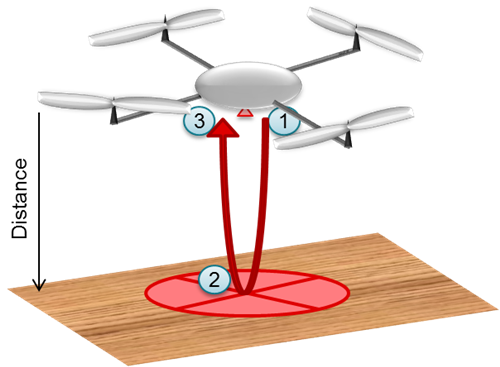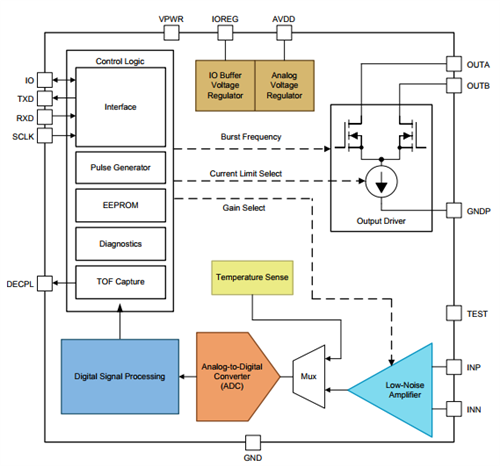SSZT908 october 2017 PGA460 , PGA460-Q1
This blog post was co-authored by Akeem Whitehead.
Consumer drones have grown in popularity in recent years, used to capture stunning footage, carry rescue supplies and even for racing. Most drones use various sensing technologies for autonomous navigation, collision detection and many other functions. Ultrasonic sensing in particular assists with drone landing, hovering and ground tracking.
Drone-landing assist is a drone’s ability to detect the distance from the bottom of the drone to the landing area, decide if the spot is safe to land, and then slowly descend to the landing area. While GPS monitoring, barometric sensing and other sensing technologies assist in the landing process, ultrasonic sensing is the primary and most accurate source of knowledge for the drone during this process. There are also hover and ground tracking modes in most drones, primarily used for capturing footage and land navigation, in which the ultrasonic sensors help to keep the drone at a constant height above the ground. Part 1 of this blog series discussed how ultrasonic sensors can be designed into automotive applications. This blog will explore the reasons ultrasonic sensing can be used for these drone applications.
Principles of Ultrasound
 Figure 1 Ultrasound Range
Figure 1 Ultrasound RangeUltrasound waves can travel through a wide variety of media (gases, liquids, solids) to detect objects with mismatched acoustic impedances. The speed of sound is the distance per unit time by a sound wave as it propagates through an elastic medium. For example, in dry air at 20°C (68°F), the speed of sound is 343 meters per second (1,125 feet per second). Ultrasound attenuation in air increases as a function of frequency and humidity. Therefore, air-coupled ultrasound is typically limited to frequencies below 500kHz due to excessive path loss/absorption.
Ultrasonic ToF
 Figure 2 Depiction of Ultrasonic ToF
for Drone Landing
Figure 2 Depiction of Ultrasonic ToF
for Drone LandingAt point No. 1 in Figure 2 and Figure 3, the drone’s ultrasonic transducer emits a sound, represented as saturated data at the return signal-processing path. After transmission, the signal-processing path becomes silent (point No. 2) until the echo returns to the sensor after reflecting from the object (point No. 3).
 Figure 3 Phases of Ultrasonic
ToF
Figure 3 Phases of Ultrasonic
ToFEquation 1 calculates the distance from the drone to the ground or from the drone to another object:

where distance (d) is the distance from the ultrasonic sensor on the drone to the ground/object, ToF (t) is the ToF as defined earlier, and SpeedOfSound (v) is the speed of sound through the medium. The ToF (t) × SpeedOfSound (v) is divided by 2 because ToF calculates the round-trip time of an ultrasound echo traversing to and from the object.
Why Should You Use Ultrasonic Sensing for Drone Landing?
TI’s PGA460 is an ultrasonic signal processor and transducer driver designed for ultrasonic sensing in air-coupled applications such as drones and can meet or exceed this 5m requirement. However, the trade-off with ultrasonic sensing is the limitation in the near-field detection of objects. All ultrasonic transducers for air-coupled applications have a period of excitation called the decay time or ringing time in which the piezoelectric membrane vibrates and emits ultrasonic energy, making it difficult to detect any incoming echoes.
In order to effectively measure objects during the ringing time, many drone designers include separate transducers for the transmitter and receiver. By separating the receiver, drones can detect objects during the excitation period of the transmitter. This results in superior near-field detection – down to 5cm or less with PGA460.
Ultrasonic sensing is also a cost-competitive technology, especially when using an integrated solution such as the PGA460, which includes most of the silicon needed. The PGA460 can either directly drive the transducer using a half-bridge or H-bridge, or drive the transducer using a transformer; the latter is used primarily for hermetically sealed “closed-top” transducers. The PGA460 also includes the full analog front end for receiving and conditioning the ultrasonic echo. In addition, the device can compute the ToF through digital signal processing – see Figure 4.
 Figure 4 PGA460 Functional Block
Diagram
Figure 4 PGA460 Functional Block
DiagramFinally, ultrasonic sensing can detect surfaces that can be tricky for some other technologies. For example, drones frequently encounter glass windows and other glass surfaces on buildings. Light-based sensing technologies sometimes pass through glass and other transparent materials, which can pose a problem for drones hovering over a glass building. Ultrasound reliably reflects off of glass surfaces.
While ultrasonic sensing is primarily used for landing assist and hovering in drones today, its strong price-to-performance ratio is motivating drone designers to explore additional applications of the technology. In the rapidly evolving drone space, the possibilities are vast.
To receive posts like this delivered to your inbox, sign in and subscribe to Analog Wire.
Additional Resources
- Order the PGA460-Q1 evaluation module (EVM).
- Watch the PGA460-Q1EVM training video series.